PKNH_0942800 ras-related protein Rab-6, putative (RAB6)
Disruptability [+]
| Species | Disruptability | Reference | Submitter | |
|---|---|---|---|---|
| P. berghei ANKA |
Refractory |
PlasmoGEM (Barseq) | PlasmoGEM | |
| P. falciparum 3D7 |
Possible |
USF piggyBac screen (Insert. mut.) | USF PiggyBac Screen | |
Mutant phenotypes [+]
None reported yet. Please press the '+' button above to add one.Imaging data (from Malaria Metabolic Pathways)
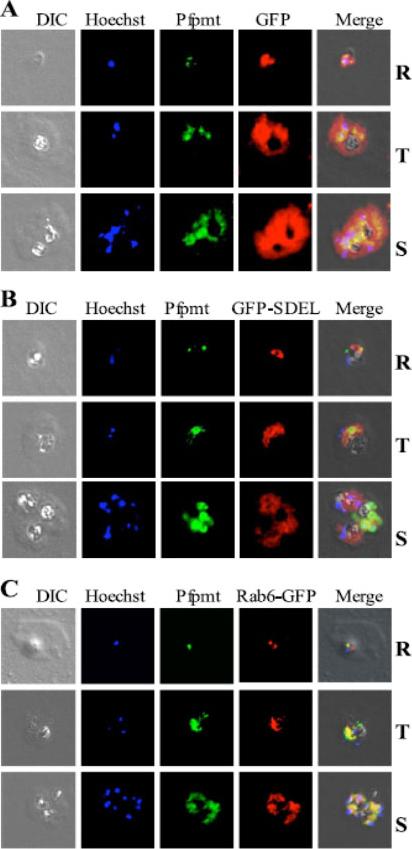
Immunofluorescence microscopy of Pfpmt in transgenic P. falciparum-infected red blood cells expressing GFP in the cytoplasm, ER, and Golgi apparatus. Erythrocytes infected with transgenic parasites expressing GFP in the cytoplasm (GFP) ( panel A), the ER (GFP-SDEL-PF14_0046) (panel B), and Golgi apparatus (Rab6-GFP PF11_0461) (panel C) at different stages of parasite intraerythrocytic development. Parasites were examined by microscopy using illumination at 546 nm to visualize Pfpmt (green) conjugated to the fluorescein isothiocyanate-conjugated anti-rabbit secondary antibody or at 488 nm to visualize GFP complexed with the Texas Red-conjugated anti-mouse secondary antibody (red). DNA was counterstained with Hoechst (blue). DIC, differential interference contrast images of parasitized erythrocytes. R, ring; T, trophozoite; S, schizont.Confocal microscopy revealed that Pfpmt is not cytoplasmic and complete co-localization was detected with Rab6, a marker of the Golgi apparatus.Witola WH, Pessi G, El Bissati K, Reynolds JM, Mamoun CB. Localization of the phosphoethanolamine methyltransferase of the human malaria parasite Plasmodium falciparum to the Golgi apparatus. J Biol Chem. 2006 281:21305-11.
See original on MMP
Fluorescence microscopy on fixed parasites. (A) PfGRASP-GFP colocalises with antiPfGRASP-specific antibodies. PfGRASP-GFP is tightly confined to two compartments (a, green) near the parasite nucleus (a, blue). AntiPfGRASP-specific antibodies show a similar staining pattern (b, red with nucleus in blue). Merged image shows identical colocalisation. (B) PfGRASP-GFP colocalises with the cis-Golgi marker ERD2. PfGRASP-GFP (a, green) accumulates in two discrete compartments in close proximity to the nucleus (a, blue). Anti-PfERD2 antibodies recognize similar structures (b, red with nucleus in blue). Merged image shows colocalisation of compartments (c, yellow). (C) PfGRASP-GFP defines a compartment that is distinct from the ER. At the early stages of the parasite life cycle (<16 hours post invasion) PfGRASP is restricted to one compartment (a, green) juxtapose to the nucleus (a, blue). The ER is visualised by anti-PfBiP-specific antibodies (b, red). The membranous system of the ER forms an envelope around the nucleus (b, blue) with one protrusion (indicated by arrow). Merged image shows no colocalisation of the two compartments (c). (D) PfGRASP-GFP does not colocalise with the trans-Golgi marker PfRab6. PfGRASP accumulates in two discrete foci (a, green) adjacent to the nucleus (a, blue). Antibodies against PfRab6 visualise two distinct sites within the parasite (b, red with nucleus in blue). Merged image shows no colocalisation of the PfGRASP defined compartment with PfRab6 (c).Struck NS, de Souza Dias S, Langer C, Marti M, Pearce JA, Cowman AF, Gilberger TW. Re-defining the Golgi complex in Plasmodium falciparum using the novel Golgi marker PfGRASP. J Cell Sci. 2005 118(Pt 23):5603-13.
See original on MMP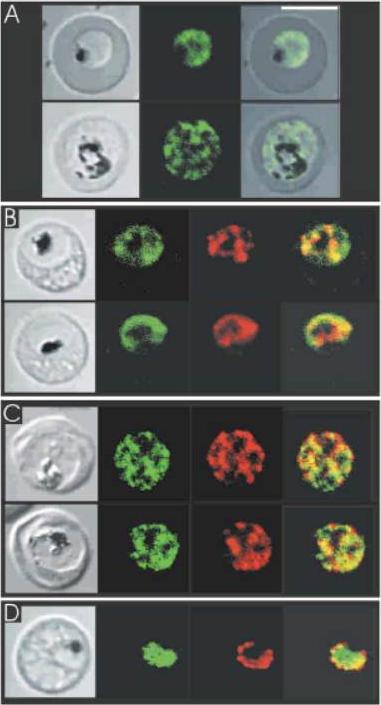
Intracellular location of Pfd-COP and comparison with the locations of the ER-located protein, PfERC, the trans -Golgi marker, PfRab6, and the PV-located protein, Exp-1. (A) Erythrocytes infected with young trophozoite stage (top panels) or mature trophozoite stage (bottom panels) malaria parasites (FAC8 strain) were labeled with affinity purified rabbit anti-GST-Pfd-COP(90) antiserum followed by an FITC-conjugated anti-rabbit IgG. (B) Erythrocytes infected with trophozoite stage parasites (FAC8 strain) were labeled with affinity purified rabbit anti-GST-Pfd-COP(90) antiserum followed by an FITC-conjugated anti-rabbit IgG (green fluorescence) and a murine antiserum recognizing the ER-located protein, PfERC, followed by Alexa Fluor 568-conjugated anti-mouse IgG (red fluorescence). (C) Erythrocytes infected with trophozoite stage parasites (FAC8 strain) were labeled with affinity purified rabbit anti-GST-Pfd-COP(90) antiserum followed by an FITC-conjugated anti-rabbit IgG (green fluorescence) and a murine MAb recognizing the Golgi protein, PfRab6, followed by Alexa Fluor 568-conjugated anti-mouse IgG (red fluorescence). (D) Erythrocytes infected with trophozoite stage parasites (FAC8 strain) were labeled with affinity purified rabbit anti-GST-Pfd-COP(90) antiserum followed by an FITC-conjugated anti rabbit IgG (green fluorescence) and a murine MAb recognizing the PV located protein, Exp-1 PF11_0224, followed by Alexa Fluor 568-conjugated antimouse IgG (red fluorescence). Differential interference contrast (DIC) images are shown in the left hand panels. Overlays of the DIC and green fluorescence channels are shown in the right hand panels of (A). Overlays of the green and red fluorescence channels are shown in the right hand panels of (B-D). Optical slices were collected by confocal microscopy through the centre of the parasite. The bar in the top right hand panel represents 5 mm.Adisa A, Rug M, Foley M, Tilley L. Characterisation of a delta-COP homologue in the malaria parasite, Plasmodium falciparum. Mol Biochem Parasitol. 2002 123:11-21. Copyright Elsevier 2010.
See original on MMP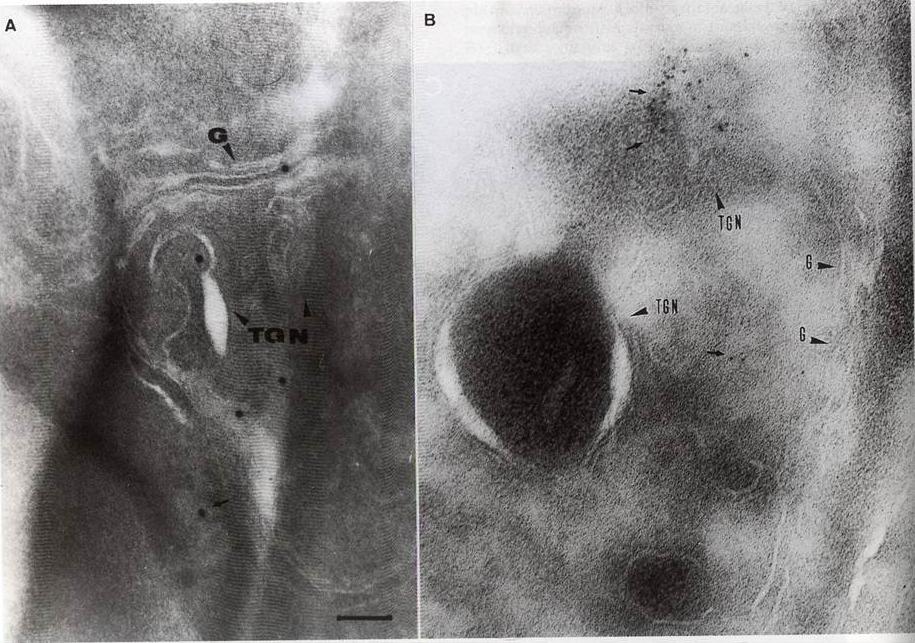
Localization of Rab 6-related proteins. Immunogold labeling of ultrathin sections of parasites with affinity-purified Rab 6 antibodies. A. Gold particles (10 nm) are associated with Golgi stacks (G) and vesicles budding from this stacks (TNGL, trans Gologi-like structures). B. 5 nm gold particles found in close relation with Golgi and vesicles. Bar - 100 nm.Jambou R, Zahraoui A, Olofsson B, Tavitian A, Jaureguiberry G. Small GTP-binding proteins in Plasmodium falciparum. Biol Cell. 1996 88:113-21.
See original on MMP
Cis- versus trans-Golgi dynamics during the asexual life cycle of P. falciparum. GRASP–GFP and DsRed–Rab6 were used to visualize the spatial organization of the cis- and trans face of the Golgi in ring stages (a), early (b) and late schizonts (c). The initially close connection between the cis- and trans-face of the Golgi in young parasites (a) appears to expand during maturation (b), resulting in a clearly distinct trans-Golgi compartment in schizonts (c). The boxed regions in a-c are depicted in higher magnification in 1-3.Struck NS, Herrmann S, Schmuck-Barkmann I, de Souza Dias S, Haase S, Cabrera AL, Treeck M, Bruns C, Langer C, Cowman AF, Marti M, Spielmann T, Gilberger TW. Spatial dissection of the cis- and trans-Golgi compartments in the malaria parasite Plasmodium falciparum. Mol Microbiol. 2008 67:1320-30.
See original on MMP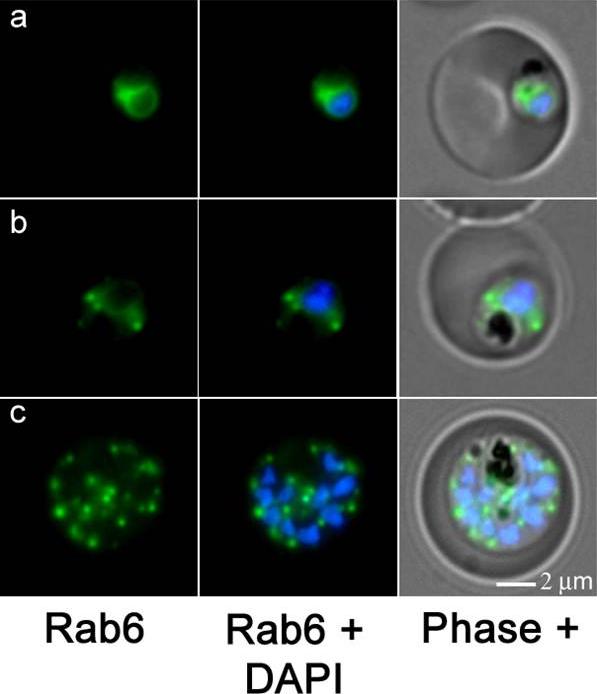
Dynamics of GFP–Rab6 expressing parasites during the asexual life cycle of P. falciparum. GFP fluorescence is focused in one defined area in close proximity to the nucleus with some additional ER staining and cytoplasmic background in ring stage parasites (a). Multiplication of the GFP–Rab6 compartment takes place prior to nuclear division (b). As the parasite matures, the GFP–Rab6 compartments further multiply (c). The transport of proteins from the endoplasmic reticulum (ER) to the cis-side of the Golgi complex takes place at specialized ER sub-domains known as transitional ER (tER). Golgi multiplication is closely linked to tER multiplication, and that parasite maturation is accompanied by the spatial separation of the cis- and trans- face of this organelle.Struck NS, Herrmann S, Schmuck-Barkmann I, de Souza Dias S, Haase S, Cabrera AL, Treeck M, Bruns C, Langer C, Cowman AF, Marti M, Spielmann T, Gilberger TW. Spatial dissection of the cis- and trans-Golgi compartments in the malaria parasite Plasmodium falciparum. Mol Microbiol. 2008 67:1320-30.
See original on MMP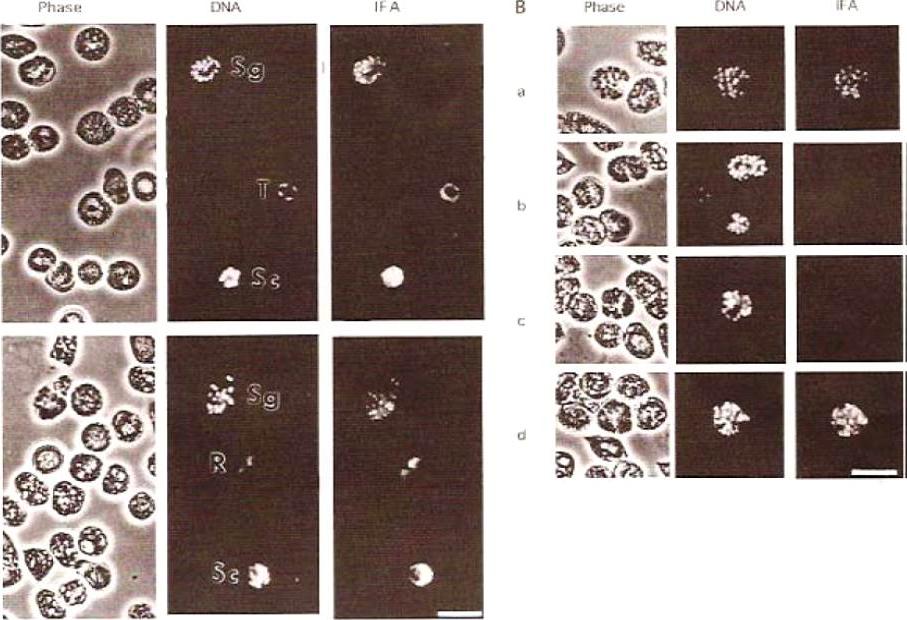
Immunofluorescence localization of Rab6 within P. falciparum-infected erythrocytes. (A) Thin films of cultured parasites were fixed in methanol and incubated with anti-Rab6i antiserum (a), or anti-Rab6i IgG fraction (b), followed by fluorescein-conjugated secondary antibody. Parasites at different stages of the intraerythrocytic cycle (R, ring; note this erythrocyte is infected with two parasites; T, trophozoite: SC, schizont; Sg, segmentor) are indicated. A phase contrast image (Phase) together with the corresponding bisbenzimide H33342 fluorescence (DNA), and immunoflourescence (IFA) images are shown for each sample. Scale bar = 10 mm. (B) lmmunofluorescence controls. Thin films of cultured parasites were fixed in methanol and incubated with anti-Rab6i antiserum (a) pre-immune serum (b) or anti-Rab6i IgG fraction (c, d), followed by fluorescein-conjugated secondary antibody. Before applying to the parasites, the anti-Rab6i IgG used in (c, d) was pre-incubated for 60 min at 23°C with either 125 ,uM peptide Rab6i (c) or 125 /tM peptide Rab6c (d). Scale bar = 5 mm. Immunofluorescence microscopy shows that the distribution of PfRab6 changes during the final stages of parasite maturation, coalescing into multiple foci, each of which is associated with the nucleus of a forming daughter parasite.de Castro FA, Ward GE, Jambou R, Attal G, Mayau V, Jaureguiberry G, Braun-Breton C, Chakrabarti D, Langsley G. Identification of a family of Rab G-proteins in Plasmodium falciparum and a detailed characterisation of pfrab6. Mol Biochem Parasitol. 1996 80:77-88. Copyright Elsevier
See original on MMP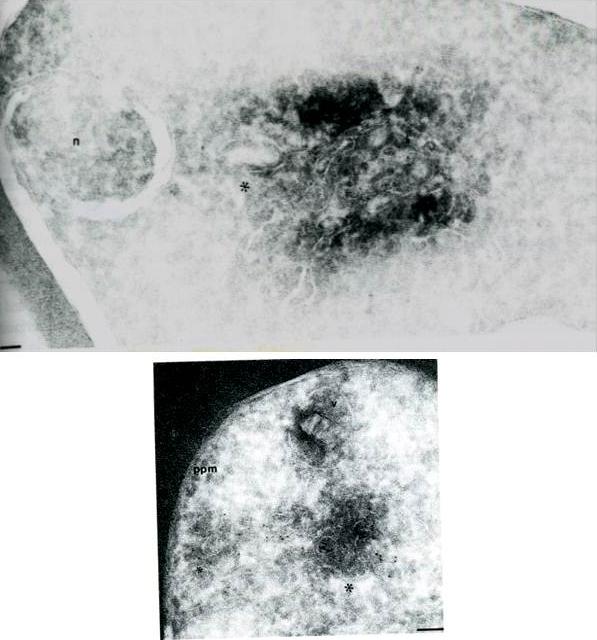
Cryosections of ring/trophozoite-infected Erythrocytes were probed with anti-Pf ERD2 (A) antibodies from non-immune sera (B) or anti-Pfrab6 (C) and goat anit-rabbit antibodies conjugated to 5 nm gold particles. In panel A, labeling of PfERD2 is detected in a perinuclear, tubulovesicular structure (*) with 1:100 anti PfERD2. The nucleus is marked by a n. Bar indicates 0.08 mm. In panel B, labeling of Pfrab6 (1:1OO) is seen in tubulovesicular clusters in peripheral regions of the cell. One cluster (large *) is proximal to the digestive food vacuole (marked with v). A second tubulovesicular cluster (small *) lies next to the parasite plasma membrane (marked by ppm). Bar indicates 0.1 mm. Van Wye J, Ghori N, Webster P, Mitschler RR, Elmendorf HG, Haldar K. Identification and localization of rab6, separation of rab6 from ERD2 and implications for an 'unstacked' Golgi, in Plasmodium falciparum. Mol Biochem Parasitol. 1996 83:107-20. Copyright Elsevier 2010
See original on MMP
Different PfRabs have different sub-cellular distributions in schizont-infected erythrocytes. Panel (A) shows control rabbit pre-immune serum. Panel (B) shows a multinucleated schizont decorated with anti-PfRab1A antibodies giving a perinuclear staining. Panels (C) and (D) (phase contrast) show the pattern obtained with the anti-PfRab11A antibodies. Clearly, PfRab1A and PfRab11A display different distributions. Panel (E) shows the pattern obtained with anti-Pf39 (ERC) antibodies specific for the endoplasmic reticulum. Panel (F) shows a double-labelling with anti-PfRab1A (green) and Pf39 (red) antibodies, where colocalization stains yellow. Panel (G) shows a double-labelling with anti-PfRab11A (green) and anti-Pf39 (red) and no co-localization is observed. Panel (H) shows anti-PfRab6 (green) and anti-Pf39 (red), where co-localization stains yellow.Quevillon E, Spielmann T, Brahimi K, Chattopadhyay D, Yeramian E, Langsley G. The Plasmodium falciparum family of Rab GTPases. Gene. 2003 306:13-25.
See original on MMP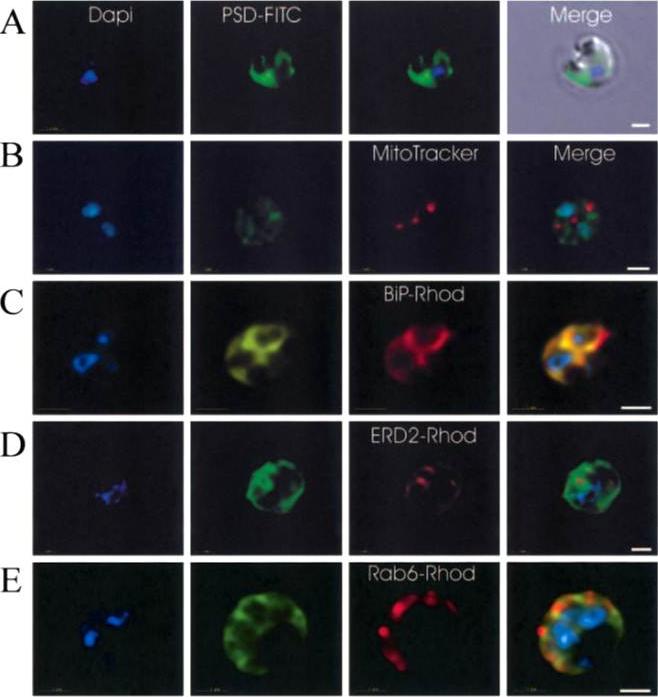
Immunofluorescence localization of PfPSD within P. falciparum-infected erythrocytes. A. FITC (which labels PfPSD) and DAPI (which labels nuclei) images were merged with the Nomarsky image to show the location of PSD labelling in the parasite. DAPI and FITC images were merged with the rhodamine channel corresponding to MitoTracker that labels the mitochondrion (B), BiP-rhodamine that labels the ER (C), ERD2-rhodamine that labels the cis-Golgi (D) or Rab6 -rhodamine that labels the trans-Golgi (E). All the images except (A) correspond to one selected z-section image after digital deconvolution. The bar corresponds to 1 mm. The entire PfPSD labelling was clearly co-localized with the BiP endoplasmic reticulum marker.Baunaure F, Eldin P, Cathiard AM, Vial H. characterization of a non-mitochondrial type I phosphatidylserine decarboxylase in Plasmodium falciparum. Mol Microbiol. 2004 51:33-46. Copyright John Wiley & Sons Ltd. 2010.
See original on MMP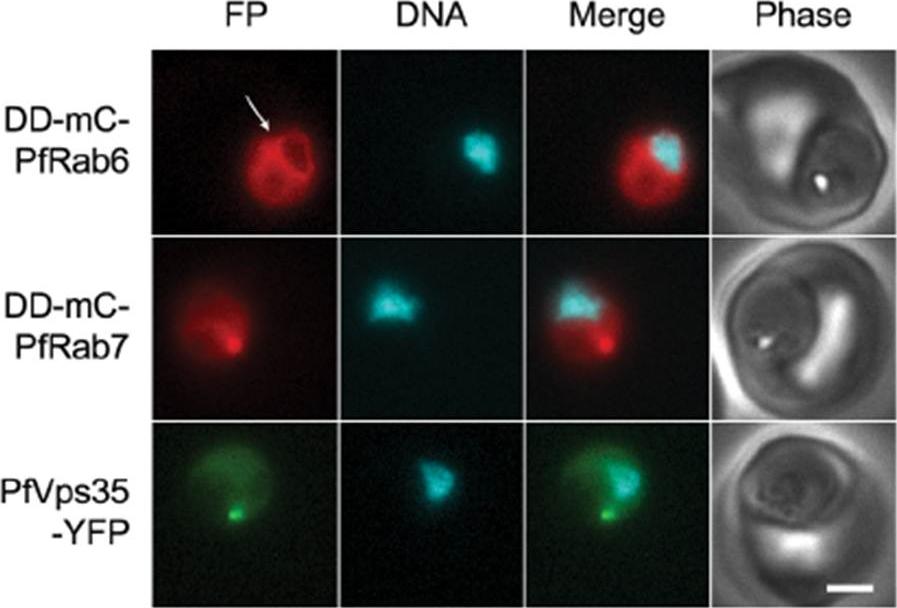
PfRab6 but not PfRab7 or retromer rapidly redistributes to the ER upon brefeldin A treatment. (A) Distributions of DDmCherry-PfRab6, DD-mCherry-PfRab7 and PfVps35-YFP in live parasites after one hour in the presence of 5 mg/mL brefeldin A. Redistribution of DDmCherry-PfRab6 to the perinuclear ER is indicated with an arrow (top panel). FP, fluorescent protein. mCherry fluorescence is pseudocolored red, YFP fluorescence is pseudocolored green and Hoechst 33342 fluorescence is pseudocolored cyan. Scale bar, 2 mm. Golgi marker DD-mCherry-PfRab6 redistributed to the perinuclear ER. Association with the perinuclear ER was not observed for either Rab7 or Vps35. The contrasting responses of the Golgi apparatus and endosome to brefeldin A treatment reveal differences in the dynamics of vesicular traffic to and from these compartments.Krai P, Dalal S, Klemba M. Evidence for a Golgi-to-Endosome Protein Sorting Pathway in Plasmodium falciparum. PLoS One. 2014 9(2):e89771.
See original on MMP
Spatial organisation of the PfGRASP-GFP defined compartment by fluorescence microscopy on fixed parasites. (A) PfGRASP-GFP colocalises with anti PfGRASP-specific antibodies. PfGRASP-GFP is tightly confined to two compartments (a, green) near theparasite nucleus (a, blue). AntiPfGRASP-specificantibodies show a similar staining pattern (b, red withnucleus in blue). Merged image shows the colocalisation of the compartments defined by either PfGRASP-specific antibodies or PfGRASP-GFP expressingparasites (c, yellow). (B) PfGRASP-GFP colocalises with the cis-Golgi marker ERD2. PfGRASP-GFP (a, green) accumulates in two discrete compartments in close proximity to the nucleus (a, blue). Anti-PfERD2 antibodies recognize similar structures (b, red with nucleus in blue). Merged image shows colocalisation of compartments (c, yellow). (C) PfGRASP-GFP defines a compartment that is distinct from the ER . At the early stages of the parasite life cycle (<16 hours post invasion) PfGRASP is restricted to one compartment (a, green) juxtapose to the nucleus (a, blue). The ER is visualised by anti-PfBiP-specific antibodies (b, red). The membranous system of the ER forms an envelope around the nucleus (b, blue) with one protrusion (indicated by arrow). Merged image shows no colocalisation of the two compartments (c). (D) PfGRASP-GFP does not colocalise with the trans-Golgi marker PfRab6. PfGRASP accumulates in two discrete foci (a, green) adjacent to the nucleus (a, blue). Antibodies against PfRab6 visualise two distinct sites within the parasite (b, red with nucleus in blue). Merged image shows no colocalisation of the PfGRASP defined compartment with PfRab6 (c) All panels labelled d in A-D are merges of fluorescent and bright-field images. Bar, 2 mm. Struck NS, de Souza Dias S, Langer C, Marti M, Pearce JA, Cowman AF, Gilberger TW. Re-defining the Golgi complex in Plasmodium falciparum using the novel Golgi marker PfGRASP. J Cell Sci. 2005 118(Pt 23):5603-13.
See original on MMP
Immunofluorescence localization of PfPSD within P. falciparum-infected erythrocytes. A. FITC (which labels PfPSD) and DAPI (which labels nuclei) images were merged with the Nomarsky image to show the location of PSD labelling in the parasite. DAPI and FITC images were merged with the rhodamine channel corresponding to MitoTracker that labels the mitochondrion (B), BiP (PFI0875w)-rhodamine that labels the ER (C), ERD2 (PF13_0280)-rhodamine that labels the cis-Golgi (D) or Rab6 (PF11_0461)-rhodamine that labels the trans-Golgi (E). All the images except (A) correspond to one selected z-section image after digital deconvolution. The bar corresponds to 1 mm. The entire PfPSD labelling was clearly co-localized with the BiP endoplasmic reticulum marker.Baunaure F, Eldin P, Cathiard AM, Vial H. characterization of a non-mitochondrial type I phosphatidylserine decarboxylase in Plasmodium falciparum. Mol Microbiol. 2004 51:33-46. Copyright John Wiley & Sons Ltd. 2010.
See original on MMPMore information
| PlasmoDB | PKNH_0942800 |
| GeneDB | PKNH_0942800 |
| Malaria Metabolic Pathways | Localisation images Pathways mapped to |
| Previous ID(s) | PK11_4440c, PKH_094250 |
| Orthologs | PBANKA_0904100 , PCHAS_0705300 , PF3D7_1144900 , PVP01_0945600 , PVX_092850 , PY17X_0905500 |
| Google Scholar | Search for all mentions of this gene |